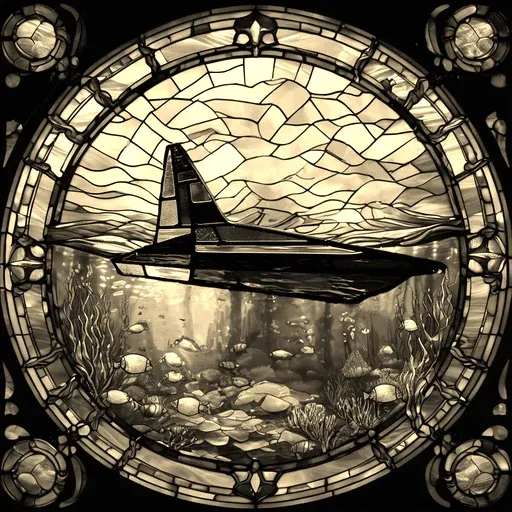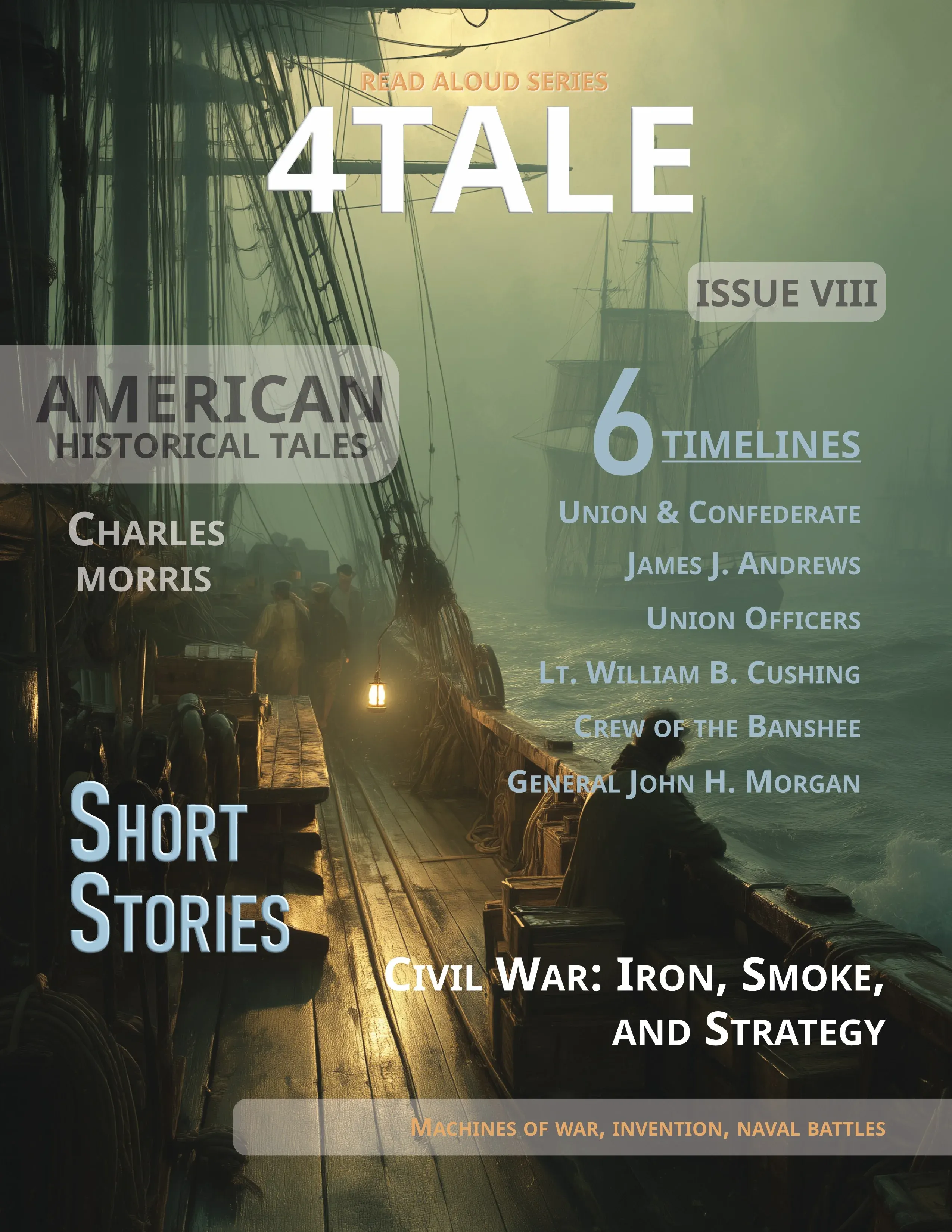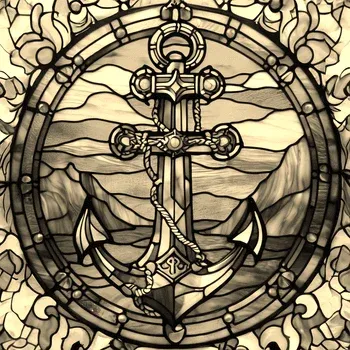Naval operations in the American Civil War were particularly distinguished by the active building of iron-clads. The North built and employed them with marked success; the South, with marked failure. With praiseworthy energy and at great cost the Confederates produced iron-clad vessels of war in Norfolk Harbor, on Roanoke River, in the Mississippi, and elsewhere, yet, with the exception of the one day's raid of ruin of the Merrimac in Hampton Roads, their labor was almost in vain, their expensive war-vessels went down in the engulfing waters or went up in flame and smoke. Their efforts in this direction were simply conspicuous examples of non-success. We propose here to tell the tale of disaster of the Albemarle, one of these iron-clads, and the great deed of heroism which brought her career to an untimely end.
The Albemarle was built on the Roanoke River in 1863. She was of light draught, but of considerable length and width, her hull above the water-line being covered with four inches of iron bars. Such an armor would be like paper against the great guns of to-day; then it served its purpose well. The competition for effectiveness between rifled cannon and armor plates had not yet begun.
April, 1864, had arrived before this formidable opponent of the Union blockading fleet was ready for service. Then, one misty morning, down the river she went, on her mission of death and destruction. The opening of her career was promising. She attacked the Union gunboats and fort at Plymouth, near the mouth of the river, captured one of the boats, sunk another, and aided in forcing the fort to surrender, its garrison being taken prisoners. It had been assailed at the same time by a strong land force, and the next day Plymouth itself was taken by the Confederate troops, with a heavy Union loss in men and material.
So far favoring fortune had attended the Albemarle. Enlivened with success, on a morning in May she steamed out into the deeper waters of Albemarle Bay, confident on playing the same rôle with the wooden vessels there that the Merrimac had played in Hampton Roads. She failed in this laudable enterprise. The Albemarle was not so formidable as the Merrimac. The steamers of war which she was to meet were more formidable than the Congress and the Cumberland. She first encountered the Sassacus, a vessel of powerful armament. More agile than the iron-clad, the Sassacus played round her, exchanging shots, and seeking a vulnerable point. At length, under a full head of steam, she dashed on the monster, striking a blow which drove it bodily half under the water. Recovering from the blow, the two vessels, almost side by side, hurled 100-pound balls upon each other. Most of those of the Sassacus bounded from the mailed sides of her antagonist, like hail from stone walls. But three of them entered a port, and did sad work within. In reply the Albemarle sent one of her great bolts through a boiler of the Sassacus, filling her with steam. So far the iron-clad had the best of the game; but others of the fleet were now near at hand; the balls which had entered her port had done serious injury; she was no longer in fighting trim; she turned and made the best of her way back to Plymouth, firing as she fled.
This ended her career for that summer. But repairs were made, and she was put in fighting trim again; another gunboat was building as a consort; unless something were quickly done she would soon be in Albemarle Sound again, with possibly a different tale to tell from that of her first assault.
At this critical juncture Lieutenant William B. Cushing, a very young but a very bold officer, proposed a daring plan; no less a one than to attack the Albemarle at her wharf, explode a torpedo under her hull, and send her, if possible, to the bottom of the Roanoke. He proposed to use a swift steam-launch, run up the stream at night, and assail the iron-clad where she lay in fancied security. From the bow of the launch protruded a long spar, loaded at its end with a 100-pound dynamite cartridge. The spar could be lowered by pulling one rope, the cartridge detached by pulling another, and the dynamite exploded by pulling a third.
The proposed exploit was a highly perilous one. The Albemarle lay eight miles up the river. Plymouth was garrisoned by several thousand soldiers, and the banks of the stream were patrolled by sentinels all the way down to the bay. It was more than likely that none of the adventurers would live to return. Yet Cushing and the crew of seven daring men whom he selected were willing to take the risk, and the naval commanders, to whom success in such an enterprise promised the most valuable results, agreed to let them go.
It was a dark night in which the expedition set out,—that of October 27, 1864. Up the stream headed the little launch, with her crew of seven, and towing two boats, each containing ten men, armed with cutlasses, grenades, and revolvers. Silently they proceeded, keeping to mid-stream, so as to avoid alarming the sentinels on the banks. In this success was attained; the eight miles were passed and the front of the town reached without the Confederates having an inkling of the disaster in store for them.
Reaching Plymouth, Lieutenant Cushing came to a quick decision as to what had best be done. He knew the town well. No alarm had been given. He might land a party and take the Albemarle by surprise. He could land his men on the lower wharf, lead them stealthily through the dark streets, leap with them upon the iron-clad, surprise the officers and crew, and capture the vessel at her moorings. It was an enterprise of frightful risk, yet Cushing was just the man for it, and his men would follow wherever he should lead. A low order was given. The launch turned and glided almost noiselessly towards the wharf. But she was now only a short distance from the Albemarle, on whose deck the lookout was wide-awake.
"What boat is that?" came a loud hail.
No reply. The launch glided on.
"What boat is that?" came the hail again, sharper than before.
"Cast off!" said Cushing, in a low tone. The two boats were loosened and drifted away. The plan of surprise was at an end. The vigilance of the lookout had made it impossible. That of destruction remained. The launch was turned again, and moved once more towards the Albemarle.
They were quickly so close that the hull of the iron-clad loomed darkly above them. Upon that vessel all was commotion. The unanswered hail was followed by the springing of rattles, ringing of bells, running of men, and shouting of orders. Muskets were fired at random at the dimly seen black object. Bullets whizzed past the devoted crew. Lights began to flash here and there. A minute before all had been rest and silence; now all was noise, alarm, and commotion.
All this did not disconcert the intrepid commander of the launch. His main concern at that moment was an unexpected obstacle he had discovered, and which threatened to defeat his enterprise. A raft of logs had been placed around the iron-clad to protect her from any such attack. There she lay, not fifty feet away; but this seemingly insuperable obstacle intervened.
What was to be done? In emergencies like that men think quickly and to the point. The raft must be passed, or all was at an end. The logs had been long in the water, and doubtless were slippery with river slime. The launch might be run upon and over them. Once inside the raft, it could never return. No matter for that. He was there to sink the Albemarle. The smaller contingency of losing his own life was a matter to be left for an after-thought.
This decision was reached in a moment's thought. The noise above them increased. Men were running and shouting, lights flashing, landsmen, startled by the noise, hurrying to the river-bank. Without an instant's delay the launch was wheeled round, steamed rapidly into the stream until a good offing was gained, turned again, and now drove straight forward for the Albemarle with all the power of her engines. As she came near bullets poured like hail across her decks. One tore off the sole of Cushing's shoe; another went through the back of his coat; it was perilously close and hot work. The hail came again:
"What boat is that?"
This time Lieutenant Cushing replied. His reply was not in words, however, but in a howitzer load of canister which drove across the Albemarle's deck. The next minute the bow of the launch struck the logs. As had been expected, the light craft slid up on their slippery surfaces, forcing them down into the water. The end of the spar almost touched the iron hull of the destined victim.
The first rope was loosened. The spar, with its load, dropped under water. The launch was still gliding onward, and carrying the spar forward. The second cord was pulled; the torpedo dropped from the spar. At this moment a bullet cut across the left palm of the gallant Cushing. As it did so he pulled the third cord. The next instant a surging column of water was raised, lifting the Albemarle as though the great iron-clad were of feather weight. At the same instant a cannon, its muzzle not fifteen feet away, sent its charge rending through the timbers of the launch.
The Albemarle, lifted for a moment on the boiling surge, settled down into the mud of her shallow anchorage, never more to swim, with a great hole torn in her bottom. The torpedo had done its work. Cushing had earned his fame.
"Surrender!" came a loud shout from Confederate lungs.
"Never!" shouted Cushing in reply. "Save yourselves!" he said to his men.
In an instant he had thrown off coat, shoes, sword, and pistols, and plunged into the waters that rolled darkly at his feet, and in which he had just dug a grave for the Albemarle. His men sprung beside him, and struck out boldly for the farther shore.
All this had passed in far less time than it takes to tell it. Little more than five minutes had passed since the first hail, and already the Albemarle was a wreck, the launch destroyed, her crew swimming for their lives, and bullets from deck and shore pouring thickly across the dark stream.
The incensed Confederates hastily manned boats and pushed out into the stream. In a few minutes they had captured most of the swimming crew. One sank and was drowned. One reached the shore. The gallant commander of the launch they failed to find. They called his name,—they had learned it from their prisoners,—but no answer came, and the darkness veiled him from view. Had he gone to the bottom? Such most of the searchers deemed to be his fate.
In a few minutes the light of a blazing fire flashed across the river from Plymouth wharf. It failed to reveal any swimming forms. The impression became general that the daring commander was drowned. After some further search most of the boats returned, deeming their work at an end.
They had not sought far or fast enough. Cushing had reached shore—on the Plymouth side—before the fire was kindled. He was chilled and exhausted, but he dared not stop to rest. Boats were still patrolling the stream; parties of search might soon be scouring the river-banks; the moments were precious, he must hasten on.
He found himself near the walls of a fort. On its parapet, towering gloomily above him, a sentinel could be seen, pacing steadily to and fro. The fugitive lay almost under his eyes. A bushy swamp lay not far beyond, but to reach its shelter he must cross an open space forty feet wide in full view of this man. The sentinel walks away. Cushing makes a dash for life. But not half the space is traversed when his backward glancing eye sees the sentinel about to turn. Down he goes on his back in the rushes, trusting to their friendly shelter and the gloom of the night to keep him from sight.
As he lies there, slowly gaining breath after his excited effort, four men—two of them officers—pass so close that they almost tread on his extended form, seeking him, but failing to see what lies nearly under their feet. They pass on, talking of the night's startling event. Cushing dares not rise again. Yet the swamp must be gained, and speedily. Still flat on his back, he digs his heels into the soft earth, and pushes himself inch by inch through the rushes, until, with a warm heart-throb of hope, he feels the welcome dampness of the swamp.
It proves to be no pleasant refuge. The mire is too deep to walk in, while above it grow tangled briers and thorny shrubs, through which he is able to pass only as before, by lying on his back, and pushing and pulling himself onward.
The hours of the night passed. Day dawned. He had made some progress, and was now at a safe distance from the fort, but found himself still in the midst of peril. Near where he lay a party of soldiers were at work, engaged in planting obstructions in the river, lest the Union fleet should follow its daring pioneers to Plymouth, now that the Albemarle was sunk, and the chief naval defence of the place gone.
Just back from the river-bank, and not far from where he lay, a cornfield lifted its yellowed plumes into the air. Cushing managed to reach its friendly shelter unobserved, and now, almost for the first time since his escape, stood upright, and behind the rustling rows made his way past the soldiers.
To his alarm, as he came near the opposite side of the field, he found himself face to face with a man who glared at him in surprise. Well he might, for the late trimly-dressed lieutenant was now a sorry sight, covered from head to foot with swamp mud, his clothes rent, and blood oozing from a hundred scratches in his skin.
He had no reason for alarm; the man was a negro; the dusky face showed sympathy under its surprise.
"I am a Union soldier," said Cushing, feeling in his heart that no slave would betray him.
"One o' dem as was in de town last night?" asked the negro.
"Yes. Have you been there? Can you tell me anything?"
"No, massa; on'y I's been tole dat dar's pow'ful bad work dar, an' de sojers is bilin' mad."
Further words passed, in the end the negro agreeing to go to the town, see for himself what harm had been done, and bring back word. Cushing would wait for him under shelter of the corn.
The old negro set out on his errand, glad of the opportunity to help one of "Massa Linkum's sojers." The lieutenant secreted himself as well as he could, and waited. An hour passed. Then steps and the rustling of the dry leaves of the corn-stalks were heard. The fugitive peeped from his ambush. To his joy he saw before him the smiling face of his dusky messenger.
"What news?" he demanded, stepping joyfully forward.
"Mighty good news, massa," said the negro, with a laugh. "Dat big iron ship's got a hole in her bottom big 'nough to drive a wagon in. She's deep in de mud, 'longside de wharf, an' folks say she'll neber git up ag'in."
"Good! She's done for, then? My work is accomplished?—Now, old man, tell me how I must go to get back to the ships."
The negro gave what directions he could, and the fugitive took to the swamp again, after a grateful good-by to his dusky friend and a warm "God-speed" from the latter. It was into a thicket of tangled shrubs that Lieutenant Cushing now plunged, so dense that he could not see ten feet in advance. But the sun was visible overhead and served him as a guide. Hour by hour he dragged himself painfully onward. At two o'clock in the afternoon he found himself on the banks of a narrow creek, a small affluent of the Roanoke.
He crouched in the bushes on the creek-side, peering warily before him. Voices reached his ears. Across the stream he saw men. A minute's observation apprised him of the situation. The men he saw to be a group of soldiers, seven in number, who had just landed from a boat in the stream. As he watched, they tied their boat to the root of a tree, and then turned into a path that led upward. Reaching a point at some distance from the river, they stopped, sat down, and began to eat their dinner.
Here was an opportunity, a desperate one, but Cushing had grown ready for desperate chances. He had had enough of wandering through mire and thorns. Without hesitation he lowered himself noiselessly into the water, swam across the stream, untied the boat, pushed it cautiously from the bank, and swam with it down the stream until far enough away to be out of sight of its recent occupants. Then he climbed into the boat and paddled away as fast as possible.
There was no sign of pursuit. The soldiers kept unsuspiciously at their mid-day meal. The swamp-lined creek-sides served well as a shelter from prying eyes. For hours Cushing pursued his slow course. The sun sank; darkness gathered; night came on. At the same time the water widened around him; he was on the surface of the Roanoke.
Onward he paddled; the night crept on till midnight was reached; for ten hours he had been at that exhausting toil. But now before his eyes appeared a welcome sight, the dark hull of a Union gunboat.
"Ship ahoy!" came a loud hail from the exhausted man.
"Who goes there?" answered the lookout on the gunboat.
"A friend. Take me up."
The gunboat was quickly in motion. This might be a Confederate ruse, possibly a torpedo might have been sent to blow them up; they were in dangerous waters. Boats were quickly lowered, and rowed towards the small object on the stream.
"Who are you?" came the cry, as they drew near.
"Lieutenant Cushing, or what is left of me."
"Cushing!" was the excited answer. "And the Albemarle?"
"Will never trouble a Union fleet again. She rests in her grave on the muddy bottom of the Roanoke."
Loud cheers followed this stirring announcement. The sailors bent to their oars, and quickly had the gallant lieutenant on board. Their cheers were heightened tenfold when the crew of the Valley City heard what had been done. In truth, the exploit of Lieutenant Cushing was one that for coolness, daring, and success in the face of seemingly insuperable obstacles has rarely been equalled in history, and the destruction of the Albemarle ranks with the most notable events in the history of war.







